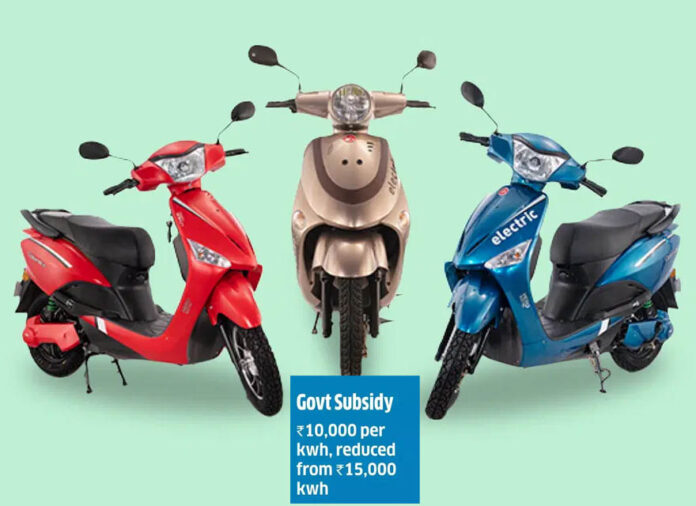
Electric two-wheelers may get costlier from June 1, 2023 with manufacturers resorting to price hikes as the FAME II subsidy cuts kick into effect.
Most are likely to do it in a staggered way. The price increase might have a short-term impact on demand, but it would even itself out in the medium to long term, manufacturers said.
Ola Electric, which leads the e-two-wheeler market with a 28% share, is set to jack up the prices of its models by Rs 15,000 each. While the price of S1 Pro will increase to Rs 1,40,000 from Rs 1,25,000, that of S1 will go up to Rs 1,30,000 from Rs 1,15,000, a company spokesperson said.
For Ather Energy, the impact owing to reduction in subsidy would be an average Rs 32,500 per vehicle, but the company is unlikely to pass it on to the buyers in entirety, its chief business officer Ravneet Singh Phokela said. “We haven’t taken a call on how much to pass on. If we do it in one shot, it would be a big shock for the customers,” he told reporters.
Phokela doesn’t expect the price hike to impact demand in the medium to long term. It may lead to delay of some business plans by a few quarters, he said. While the industry must prepare for selling e-scooters without subsidy, the process has to be a gradual one, he said. “While one had anticipated this, no one expected it to happen that soon.”
Most of the other manufacturers, including TVS Motor that sells the iQube, Bajaj Auto that sells the Chetak, and Greaves Electric Mobility plan to announce price hikes on Thursday, according to their spokespersons. According to Morgan Stanley estimates, TVS iQube prices could go up by 14% to Rs 17,000 per unit. But not everyone is on board with the price hikes.
Hero Electric, which sells the Optima among other brands, has decided not to increase prices immediately. “A gradual transition with sustained subsidies would have been ideal to ensure market growth and reach the international benchmark of 20% EV adoption (presently just 4.9%) before tapering off the subsidies to the customer,” said Sohinder Singh Gill, CEO of Hero Electric. “The sudden reduction of subsidy may lead to a major decline in EV adoption, impacting the entire industry for a considerable period of time.”
“Despite the recent reduction in the FAME2 subsidy, the company remains dedicated to promoting the adoption of e-two-wheelers and dispelling misconceptions about their cost of ownership,” the company said in a statement.
In a notification last week, the ministry of heavy industries said it would reduce the subsidy on e-two wheelers to Rs 10,000 per kwh from Rs 15,000 per kwh and cap maximum subsidy at 15% of the ex-factory pricing against 40% offered earlier effective June 1.
Sales of e-two-wheelers dropped to 66,676 units in April against 86,197 units in March even as realisation per vehicle dropped as some manufacturers had to refund prices of chargers to customers to continue to avail government subsidy. “The drop in sales is not a reflection of demand, the demand remains very strong,” Phokela said. He attributed it to uncertainty around the subsidy and procedural and technical reasons.
The fall in sales resulted in e-two-wheeler penetration as the percentage of total two-wheeler sales volume to drop to 5.4% in April from 5.9% in March. To be sure, nearly Rs 1,200 crore worth of subsidy has been withheld by the government and payment has been suspended for over a year, restricting the growth of the segment. As a result, driven by issues around subsidy, the e-two-wheeler market has witnessed consolidation in the past few months with Ola and TVS gaining the most.








